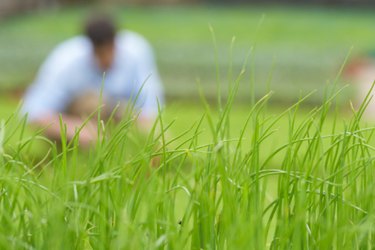
For many, the home landscape is simply not complete without a thick carpet of healthy, green grass; however, to keep a lawn looking its best, it must be fed on a regular basis. Without routine applications of fertilizers or plant foods, grass growth tends to be sparse. Thin lawns are more susceptible to insect infestation, disease development and weed growth. Grass can be fed in a number of ways, but some of the most simple, cost-effective fertilizers can be made at home using a variety of growth-boosting ingredients.
Beer-Based Fertilizer
Video of the Day
Beer is a common ingredient in homemade lawn tonics. The combination of sugars and yeasts are easily digested by soil-dwelling microbes, bolstering their growth and development. This, in turn, improves the condition of the soil and helps the grass grow. This effect can be enhanced by mixing the beer with corn syrup. Corn syrup is a natural source of nitrogen- a chemical that is used in large amounts during periods of grass growth. To use beer and corn syrup for the lawn, simply pour 1 cup of each into a hose-end sprayer, shake the canister until the two ingredients are well blended, then spray the mixture evenly over the lawn.
Video of the Day
Ammonia
Though many find the aroma of household ammonia off-putting, the nitrogen-rich liquid can be used to give struggling plants much-needed nutrient boost. Additionally, ammonia is alkaline in nature and will temporarily raise pH levels, which can be beneficial for those with highly acidic soils. To use ammonia on the lawn, pour 1/4 cup of ammonia into 1 gallon of water and stir until the two are thoroughly combined, then pour the solution over any unhealthy areas of the lawn.
Coffee
To increase the germination rate of a newly established lawn, mix an equal measure of freshly ground coffee with the seeds before sowing them. The texture of the coffee make the seeds easier to sow, and the aroma of fresh grounds repels maggots, grubs and seed-eating pests. Additionally, the coffee will gradually decompose, improving the texture of the soil and providing the roots of the lawn with a continuous supply of essential nutrients. Throughout the year, old coffee grounds can be scattered over the lawn to provide the grass with an organic source of slow-release nitrogen.
Compost Tea
Those with a compost pile can feed the lawn by mixing the compost with water to create a highly nutritious "tea." Simply stuff an old nylon with compost, tie the end, then submerge the stocking in a bucket filled with lukewarm tap water. Cover the bucket and set it aside; stir the tea once a day for seven to 14 days to encourage the flow of oxygen throughout the mixture; when the brew turns dark brown, transfer it to a sprayer or watering can and apply it to the lawn.
Considerations
While these basic home remedies can be used in combination with each other, take care when using mixtures of ingredients; even something as benign as coffee grounds can be turn out to be too much of a good thing when combined with other nitrogen-rich compounds. That being said, homemade lawn fertilizers are not as potent as commercially prepared formulas; therefore, they should be applied more often. At a minimum, the lawn needs to be fed in the early spring, in the mid-summer and again in the fall; however, many homemade fertilizers can safely be applied every four weeks for the duration of the growing season.